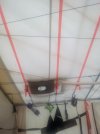Here are a couple pictures for perspective.
This is the back side of the tents. Right is the 10x14, left is the 10x19.5
Wood poles are 12' 4x4's I split out of some 4'x12' pallets. All cordage is 550 paracord. The flagged stakes are 18" 1/2" rebar (anchors for the wood poles etc).
View attachment 477205
Below is the front side. The canopy is a "common area". In looking at my Wall Tent idea this would be the "cook shack".
The tarps give us a lot of area to store things "under cover" outside of the tents also. That will be a consideration with my wall tent idea, however we are going to have a substantial amount more room inside if I use the 2x 14x15 "tents" with a "cook shack" sandwiched between - the cook shack space would likely cover everything.
I'll have to give the idea of the "cook shack" some more thought. In the specific set up here that might not be entirely ideal. Rather, an awning the same size might be better - with removable sides. That way we have the roof over-head, but if the wind kicks up or there's a storm we would have the option of closing in the sides. With a walled "cook shack" you couldn't open it up the same way. In the colder weather, though, the walled "cook shack" would be ideal. Plus that can double as its own smaller stand-alone tent.
View attachment 477206
A bit off topic, but a good topic to expand the perspective of things - in the top 1st picture, the upper right of it you can see a guy line going bottom left to upper right. That is the top guy support for the 65' antenna. Heres a better (not great) picture of it below. That gets back to a point I made earlier on about guying things down and the strength of guys. We've been doing it for years with a lot of various things.
The ladder in the background is the "launch pad". The 4 way guy system is set up so when going up and down the side pair holds the mast steady, the rear holds it from cresting and falling forward, and the front pair works in conjunction with ratchet straps so as to be able to adjust the top and bottom guy lengths in increments. An ATV winch (anchored to the ground with 2x 1/2" rebar stakes in series) with wireless remote is the pulling power. Having the mast set on the ladder gives the initial angle needed for the winch pressure to raise it (with a little help from a push stick at first).
View attachment 477207














